
Foot & Ankle
Foot & Ankle injuries commonly occur during sporting activities such as running and jumping. Conditions that affect the foot can be caused by direct injury, repetitive overuse or poor foot posture such as flat footedness.
Our physiotherapists are experienced at treating a wide variety of foot & ankle conditions such as:
- Achilles Pain
- Achilles Tendonitis
- Ankle Sprain
- Footballers Ankle
- Plantar fasciitus
- Fat pad syndrome
- Calcaneal stress fractures
- Joint sprains
Treatment at Platinum Physiotherapy will initially involve assessing your pain, range of movement, muscle strength, balance and stability. Your physiotherapist may also look at your footwear to assess whether your ankle problem is biomechanical and related to your foot posture and the position of your knees and hips.
Following an initial assessment, your physiotherapist will develop a progressive treatment program in order to restore your physical function and proprioception (awareness of limbs in space) and get you back to the activities you enjoy as quickly as possible.
Achilles Pain
Pain in the region of the Achilles tendon is an extremely common injury especially among distance runners. Factors that may cause Achilles pain include:
- Direct injury to the Achilles tendon
- Repetitive overuse over a period of time that exceeds the ability of the Achilles tendon to endure that load
- Achilles tendonitis
- Calf strain
Physiotherapy for Achilles pain
The key to successful treatment of Achilles pain is early diagnosis and RICE (rest, ice, compression and elevation).
Our physiotherapists provide specific stretching and strengthening programmes and correction of predisposing factors such as muscle tightness and abnormal biomechanics. These are all required together with appropriate progression to functional activities and sport-specific rehabilitation programmes.
Physiotherapy treatment will settle pain and inflammation by using a combination of techniques which may include:
- Advice about heel raises and other orthotics
- Soft tissue massage and mobilization of the Achilles tendon
- Intensive self-stretching program to maintain muscle and tendon length
- Progressive strengthening program
- Gait analysis
- Running program
Your treatment program will be tailored to your needs and lifestyle to ensure you make a speedy recovery and reach your maximum potential.
Contact Us
Achilles Tendonitis
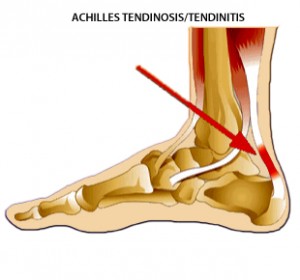 What is Achilles Tendonitis?
What is Achilles Tendonitis?
Achilles Tendonitis is the irritation and inflammation of the Achilles tendon. Although it is believed to be the thickest and most robust tendon in the body, damage does sometimes occur to the Achilles Tendon causing an extremely painful injury.
What causes Achilles Tendonitis?
The main cause of Achilles tendonitis is over-use or repetitive strain injury and therefore sports associated with running or jumping can aggravate the Achilles tendon.
Achilles Tendonitis is also commonly caused by a lack of flexibility or flat footedness. Rigidity of the tendons comes with age and therefore as we get older we become more susceptible to injury.
What are the Symptoms of Achilles Tendonitis?
The main symptom of Achilles Tendonitis is pain at the back of the heel, which is usually worse after long periods of inaction such as first thing in the morning or after sitting down for while. Aggravating activities like running and jumping are also painful.
Physiotherapy treatment for Achilles Tendonitis
Physiotherapy treatment for Achilles Tendonitis should start as soon as possible to hasten recovery and to prevent further damage.
At Platinum Physiotherapy, treatment will aim to significantly reduce pain and inflammation in the initial phase of Achilles tendonitis and then gradually improve muscle strength and flexibility to ensure an optimal outcome.
Physiotherapy treatment will be tailored to you but may include:
- Ice and heat treatment
- Soft tissue massage
- Ultrasound to accelerate healing
- Advice about insoles and orthotics
- Advice on how to modify activity while your injury is healing
- Passive stretching
- Joint mobilisation
- Exercises to improve strength, flexibility and balance
- Sport specific exercises
Your physiotherapist will guide you through an individualised exercise program to ensure you make the best possible recovery and return to your sport as safely and as quickly as possible.
Contact Us
Ankle Sprain
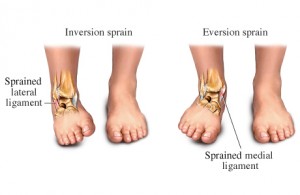 What is an ankle sprain?
What is an ankle sprain?
A sprained ankle is a condition characterised by damage and tearing to the soft tissue and ligaments of the ankle. The most commonly affected ligaments in this condition are the lateral ligaments.
What causes an ankle sprain?
An ankle sprain is commonly caused by activities requiring rapid changes in direction, especially if these take place on uneven surfaces (e.g. grass fields) such as in football or netball.
What are the symptoms/effects of an ankle sprain?
People may often notice an audible snap, crack or tearing sound at the time of injury, accompanied by:
- Pain
- Swelling
- Bruising
- Stiffness
- Difficulty weight bearing onto the affected leg
Diagnosis of an ankle sprain
Diagnosis of an ankle sprain can be made by a physiotherapist or doctor who will take a thorough look at your ankle and assess swelling, pain, movement and strength. An X-ray may be required to see the extent of the injury and rule out other injuries (particularly fractures).
Physiotherapy for an ankle sprain
At Platinum Physiotherapy we provide specialised assessment and treatment for people with ankle sprains.
Physiotherapy treatment will initially reduce pain and swelling through specific compression strapping and regular icing and elevation. Following this, range of motion and strength will be restored as quickly as possible through:
- Ankle mobilisations
- Soft tissue massage
- Specific stretching and strengthening exercises
- Balance training using wobble boards, wobble cushions and trampets
- Sport-specific exercise programme
Your treatment programme will be centred on your lifestyle to increase sporting performance and reduce the risk of recurrence.
Physiotherapy will accelerate healing and get you back to your sporting activities as quickly as possible.
Contact Us
Footballer’s Ankle
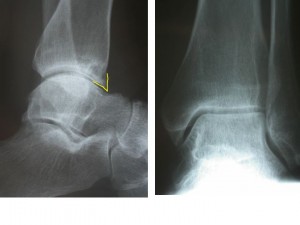
An otherwise normal ankle joint with an anterior tibial spur, also known as a Footballers Ankle
Footballer’s ankle is the name given to the dislocation of the peroneal tendons that are located behind the bony point on the inner side of your ankle (malleolus).
What Causes Footballer’s Ankle?
An ankle sprain can be the cause of Footballer’s Ankle as long as the dislocation of the peroneal tendons occurs as a result of the sprain. A direct kick to the tendon can trigger the injury and this is the cause of its name, Footballer’s Ankle.
The tissue stabilising the peroneal tendons can sometimes be torn when an ankle is turned over and the tendons can relocate themselves on the wrong side of the malleolus. When this occurs repeatedly, it causes great damage to the tissue, resulting in inflammation.
What are the Symptoms of Footballers Ankle?
Footballer’s ankle causes great pain on movement of the foot. Other symptoms are swelling, bruising and tenderness and pain behind and around the malleolus.
Diagnosis of footballer’s ankle
Diagnosis of footballer’s ankle can be confirmed by a physiotherapist or doctor following a thorough subjective and objective assessment. An X-ray may be required to see the extent of the injury and rule out other injuries, such as fractures.
Physiotherapy for footballer’s ankle
Your physiotherapist at Platinum Physiotherapy will initially assess your foot and ankle to diagnose the injury and identify possible causes. A rehabilitation program will then be developed to promote healing, restore full flexibility, strength balance and proprioception and reduce reoccurrence of the injury.
Physiotherapy treatment may include:
- Ice to ease pain and inflammation
- Advice on how to modify activity
- Once the inflammation has gone, gentle stretching
- Soft tissue massage
- Progressive strengthening and balance program
- Sport-specific exercises to ensure that you are ready to return to training and competition
- Physiotherapy treatment will return you to everyday and sporting activities safely and effectively and prevent the risk of re-injury
Plantar fasciitus
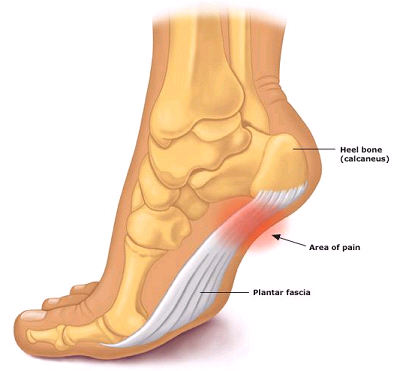 What is plantar fasciitis?
What is plantar fasciitis?
Plantar fasciitis is damage and inflammation to the connective tissue on the sole of the foot forming the inner arch (plantar fascia) causing pain in the heel.
What causes plantar fasciitis?
Plantar fasciitis is commonly caused by biomechanical abnormality, such as excessive pronation (flatfootedness) or supination (high arch) of the foot. Plantar fasciitis may also be caused by calf tightness or repetitive overuse such as walking excessively especially up hills or on uneven surfaces.
What are the symptoms/effects of plantar fasciitis?
The main symptom of plantar fasciitis is pain underneath the heel and along the inner sole of the foot, which is worse in the morning and when walking or running.
Physiotherapy treatment for plantar fasciitis
Physiotherapy treatment will reduce pain and accelerate healing so that you can get back to your sports and everyday activities as quickly as possible.
Early physiotherapy treatment is vital to speed up recovery and ensure you make significant improvement in the short and long term.
At Platinum Physiotherapy, our specialised musculoskeletal physiotherapists will initially assess your injury to identify the underlying cause and develop a treatment program accordingly which may include:
- Soft tissue massage
- Joint mobilisation
- Ultrasound
- arch support taping
- Ice or heat therapy
- Advice about heel padding, insoles or orthotics
- Exercise program to improve balance, strength and flexibility
- Biomechanical correction
- Footwear assessment
Your physiotherapist will also devise an appropriate return to activity plan so you can return to your daily tasks and hobbies with confidence and success, as soon as possible.
Contact Us
Fat pad syndrome
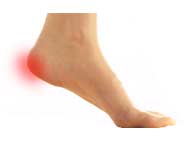 What is fat pad syndrome?
What is fat pad syndrome?
Fat pad syndrome is characterised by pain over the centre of the heel which often feels like a deep bruise. The fat pad aids in cushioning and protecting the heel. When the heel gets injured, the fat pad stretches losing some of that cushion, which can make weight bearing very uncomfortable.
What causes fat pad syndrome?
Fat pad syndrome can be caused by a direct blow to the heel such as fall onto the heels or chronically from excessive heel strike with poor heel cushioning.
What are symptoms/effects of fat pad syndrome?
Symptoms of fat pad syndrome may include:
Pain in the heel, usually on the middle of the heel which is aggravated by walking barefoot on hard surfaces like ceramic tile, concrete, hardwood floors, etc.
A deep, dull ache that feels like a bruise.
Physiotherapy for fat pad syndrome
Physiotherapy treatment will reduce your pain and accelerate healing and cushioning of the heel so that you can get back to your hobbies much quicker and with more confidence.
An initial assessment at Platinum Physiotherapy will confirm a diagnosis and identify the cause of your injury.
Your physiotherapist will then develop a treatment program which may involve:
- Advice on how to modify activity
- Advice about appropriate footwear, insoles and heel raises
- Taping the heel to provide pain relief and compress the soft tissue under the heel giving more protection to the bone.
- Ultrasound to promote healing of the fat pad
- Stretching and strengthening program
Physiotherapy treatment will be tailored to your current symptoms and lifestyle to ensure you make the best progress and continue you to make long term improvements.
Contact Us
Calcaneal stress fractures
What is a calcaneal stress fracture?
A calcaneal stress fracture is fracture of the heel bone (calcaneus).
What causes a calcaneal stress fracture?
Calcaneal stress fractures are usually caused by repetitive force going through the heel bone in weight bearing activities such as marching or running. Sometimes stress fractures of the calcaneus occur when people increase their activity or change their training conditions.
What are the symptoms/effects of a calcaneal stress fracture?
The main symptom of a calcaneal stress fracture is pain on either the inner or outer aspect of the heel bone that increases with impact activity such as marching, running, jumping or landing. Other symptoms may include night ache or pain on firmly touching or squeezing the heel bone.
Physiotherapy treatment for a calcaneal stress fracture
Physiotherapy treatment for a stress fracture of the calcaneus initially involves a period of rest which may involve protective weight bearing using crutches or wearing a protective boot.
Your physiotherapist at Platinum Physiotherapy will then use a combination of hands-on techniques and exercise to promote bone healing and get you back to your normal activities as soon as possible.
Physiotherapy treatment may include:
- Heat or Ice therapy
- Soft tissue massage to lengthen any tight muscles around the heel
- Joint mobilisation to reduce stiffness and pain
- Taping
- Advice about alternative exercises which place minimal weight bearing forces through the affected bone and to maintain fitness, such as swimming, cycling, and water running
- Hydrotherapy
- A graduated exercise program to strengthen the muscles in the legs, hips and glutes once weight bearing is appropriate
- Balance training
- Advice about insoles and orthotics
- Gait analysis
- Advice on a training program tailored to your sport to prevent re-injury
Physiotherapy treatment will not only speed up your recovery but also ensure get back to your sport and hobbies with confidence and success.
Contact Us
Joint sprains
What is a joint sprain?
A joint sprain is characterised by damage or tearing of the connective tissue (such as ligaments, cartilage and joint capsule) of one or more joints in the foot.
What causes a joint sprain?
A joint sprain in the foot is caused by an awkward movement such as twisting or bending or landing on an even surface during activities such as jumping, running, gymnastics and football. Sometimes, a sprained foot will occur due to repetitive strain associated with overuse and may occur in people with unstable foot types such as flat feet.
What are the signs and symptoms of a joint sprain?
A sudden onset of pain in the affected joint during activity is the initial symptom experienced if you have sprained a joint in your foot.
Some people may also experience pain and stiffness after the activity, particularly the next morning and the area may be tender to touch.
A joint sprain may also be accompanied by swelling, redness and bruising depending on the extent of the injury.
Physiotherapy treatment for joint sprain
Physiotherapy following a joint sprain will facilitate your recovery and get you back to your sport quicker.
Our experienced physiotherapists at Platinum Physiotherapy will initially assess your foot looking at pain, swelling, movement and strength in order to develop a treatment program tailored to you.
Treatment may include:
- Protective or postural taping
- Ice or heat treatment
- Ultrasound to accelerate healing
- Soft tissue massage
- Joint mobilization once pain and swelling has settled
- Passive stretching to regain range of movement and flexibility
- Structured exercise program to strength and balance
- Advice on training and how to return gradually and safely to your sport
Physiotherapy will reduce pain and swelling, improve muscle strength and flexibility and ensure your foot is functioning correctly before returning to sporting and everyday activities.
In cases of foot instability or poor foot posture, your physiotherapist will refer you on to an orthotist to maximise your recovery in the short and long term.
Contact Us




![axa_ppp_logo[1]](https://www.platinumphysio.co.uk/wp-content/uploads/axa_ppp_logo1.gif)

![cigna[2]](https://www.platinumphysio.co.uk/wp-content/uploads/cigna2.png)